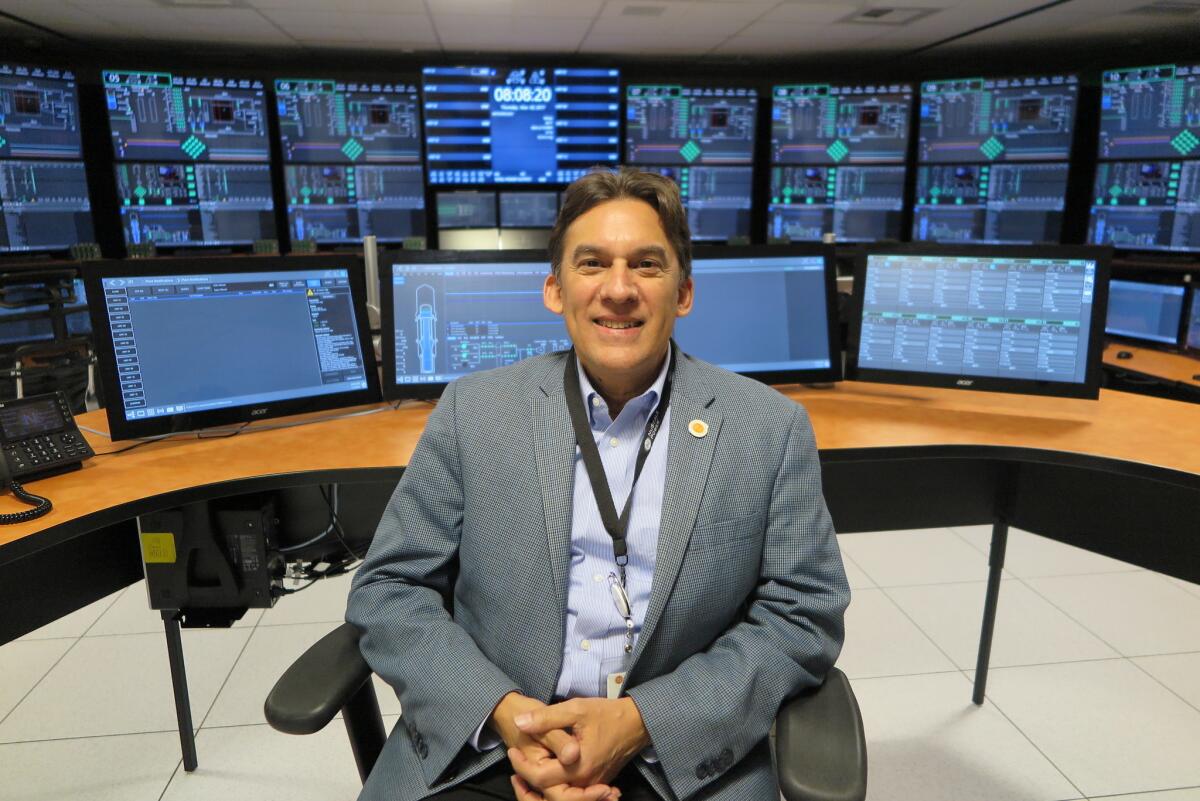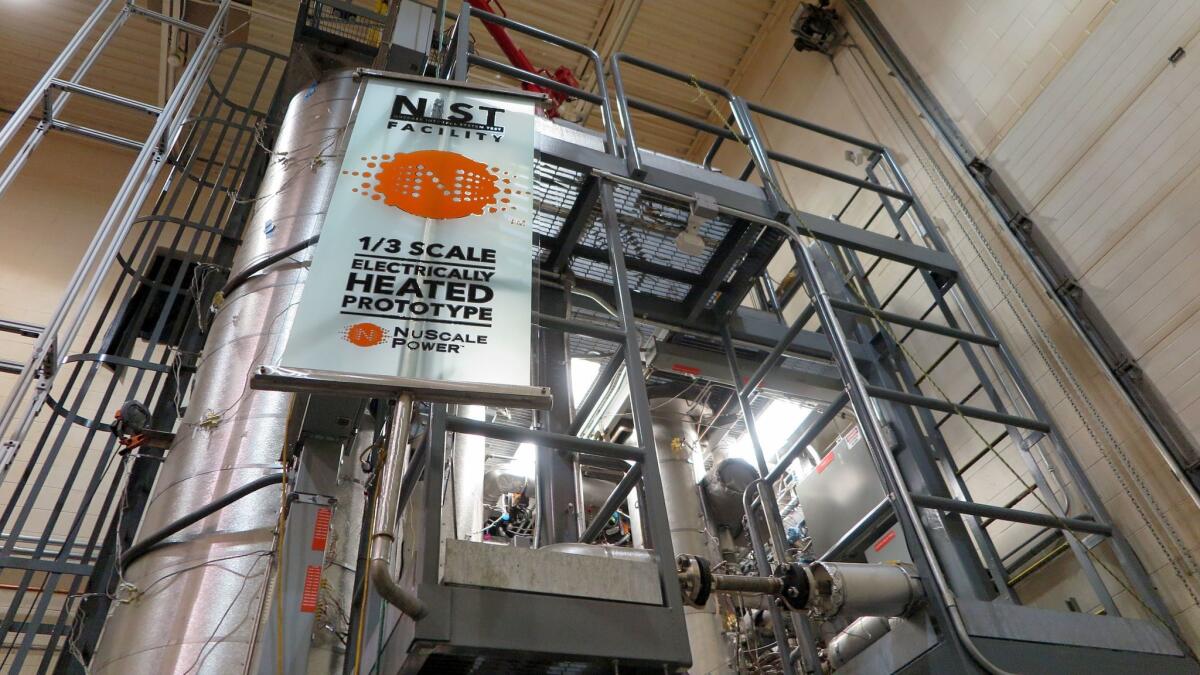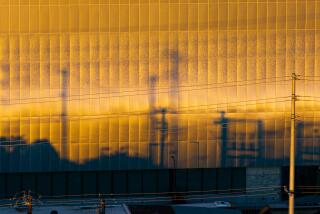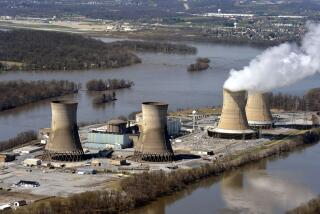The future of nuclear power? Think small

- Share via
Reporting from Corvallis, Ore. — It’s not quite Stagg Field, the University of Chicago site of the first nuclear chain reaction in 1942. But perched in what looks like a giant birdcage at Oregon State University is a steel cylinder nearly 20 feet tall, thick as a redwood, bristling with gauges and wrapped in a tangle of wires. Nearby, in a windowless control room, two dozen digital displays surround a central operations bench.
Jose Reyes, the founder of NuScale Power, showed off the facilities like an owner appraising his barn of prize thoroughbreds. “Year by year we are getting closer to our goal,” he said.
If Reyes and other experts are right, his steel cylinder — a one-third scale model of the reactor his company hopes to build — will lead a revival of U.S. commercial nuclear power by overcoming two problems that have crippled the industry: escalating costs and the risk of devastating accidents.
NuScale’s 50-megawatt reactor is tiny compared with conventional reactors and would generate a twentieth of the electricity. But because it is small, it would contain much less fuel and much less energy — and therefore could be operated with much less risk. It is designed as a modular unit that could be built in a factory, shipped by truck and put in place much like an ink cartridge is clipped into a printer. Power plants could activate one reactor and generate revenue as they install the next.
Other companies also are intent on gaining a place in the nuclear sector amid fresh interest in design and development of commercial reactors. Nine projects are underway in California, 47 more in 19 other states, and five in Canada, according to the Third Way think tank in Washington. Several are focused on small reactors.
In January, the Nuclear Regulatory Commission ruled that the design of the NuScale reactor — which relies on air circulation for cooling — is so safe that it does not need the expensive emergency pumps and backup electrical systems required of big conventional reactors. The decision brings NuScale closer than any company in decades to gaining a license to operate an entirely new reactor design in the U.S. for commercial use.
“The NuScale reactor has crossed a very important safety threshold,” said Todd Allen, professor of nuclear engineering at University of Wisconsin. “It’s an inflection point for advanced reactor designs. The question we can’t answer yet is, will they make it work in the market?”
Reyes and his backers are gambling that nuclear power will play a big role in energy markets in coming decades as safer, smaller and easier-to-operate reactors replace big conventional ones.
With more than $700 million in government and private investment, Reyes’ company already has a customer: A consortium of municipal utilities in six Western states hopes to string 12 of the reactors together in Idaho to create a 600-megawatt power plant for the bargain price — compared with other nuclear facilities — of $2.85 billion.
Even some environmental groups that once opposed nuclear power are willing to consider it now as a way of weaning the world off fossil fuels to combat global warming.
“The stars may be aligning for licensing small modular reactors,” said Matthew McKinzie, a physicist and director of the Nuclear Project in the Washington office of the Natural Resources Defense Council.
Several prominent physicists, however, expressed deep skepticism about the economic viability of the NuScale reactor, especially with solar power, wind farms and other renewable energy sources steadily getting less expensive.
“It takes steel and concrete and other materials to build these things,” said Gregory Jaczko, a physicist and former NRC chairman. “You’re not going to have better economics with small reactors as compared to big ones. They’re going in the wrong direction. Absolutely nobody out there is going to buy these small reactors.”
And small plants won’t solve perhaps the biggest problem with nuclear power: what to do with the radioactive waste. NuScale plans to store it onsite in concrete casks — “until the government decides what to do with it,” Reyes said.

Currently, nuclear power supplies 20% of the country’s electricity. But the number of reactors is on the decline, from a peak of 104 in 2012 to 99 today, with seven more scheduled for decommissioning in the next seven years, including the Diablo Canyon plant in San Luis Obispo County, California’s last nuclear power station. The newest plant opened in Tennessee in 2016 — 31 years after construction was halted due to cost and safety concerns.
In the latest blow to the industry, Westinghouse, the premiere commercial nuclear designer, went bankrupt last year, and the two 1,100-megawatt reactors it was building in South Carolina were abandoned after completion costs more than doubled to $25 billion and the construction schedule was extended by a decade.
To Reyes, those difficulties are evidence that nuclear power needs to move in a new direction.
“The design for this reactor is so different,” said Reyes, 62. “There is so much that is automated. It is so much simpler in terms of safety. I eliminated a lot of equipment. Yet we can demonstrate a much higher level of safety.”
He has been fascinated by atomic energy since he was a kid growing up in New Jersey in the 1960s, when nuclear power plants were just starting to be built. National plans for a nuclear future atomized in a cloud of radioactive gas on March 28, 1979, with the meltdown at Three Mile Island, an accident that Reyes helped investigate as a research engineer at the Nuclear Regulatory Commission.
The disaster didn’t shake Reyes’ commitment to nuclear power, but it did make clear that safety had to be the priority in any reactor design. He spent a decade at the agency before leaving in 1987 for Oregon State, where he rose to head the nuclear engineering department.
In 2000, Reyes was awarded a U.S. Department of Energy grant to design his reactor — an atomic engine that he insists could never melt down. Seven years later he launched NuScale, which has grown to 450 employees.
The Energy Department has invested $226 million in NuScale since 2013. Karla Olsen, a spokeswoman for the department’s Office of Nuclear Energy, praised the “innovative design” of the reactor and said the government was encouraged by the progress the company had made.
The company’s biggest supporter is the Fluor Corp., a Texas-based $20-billion publicly traded company that has bet $416 million since 2011 that the reactor will be the core of a nuclear construction business to power industrial installations, military bases and remote communities.
“It’s part of the next wave and it will be an incredibly powerful source of energy,” said David Seaton, the company’s chief executive. “It matches the needs of users, and also meets the terms of the green nature of this technology.”
Critics point out that even though construction costs are projected to be far lower than traditional nuclear plants, they are still far higher than for other kinds of power.
Utah Associated Municipal Power Systems — the consortium of Western state utilities that wants to build a 600-megawatt plant in Idaho using the technology — plans to spend roughly $5 million for each megawatt. An Energy Department study last year found that figure is $1.1 million for a natural gas plant and $2.2 million for a solar plant.
But Douglas Hunter, the utility’s chief executive, said the savings will come on the operations side. At 6 cents per kilowatt-hour, the plant would be cheaper to run than the utility’s wind farms in Idaho and Wyoming, and on par with its natural-gas-fired plant in Utah.
“We wanted to develop an option for nongreenhouse reliable generation,” Hunter said. “This was the only viable path to get there.”
The facility would be built by Fluor at Idaho National Laboratory, a federal nuclear reactor testing ground near Idaho Falls. If all permitting and construction goes as planned, it would start up in 2027.
That is a big if, given all the unexpected delays and cost overruns that have bedeviled the nuclear power industry.
More to Read
Sign up for Essential California
The most important California stories and recommendations in your inbox every morning.
You may occasionally receive promotional content from the Los Angeles Times.










